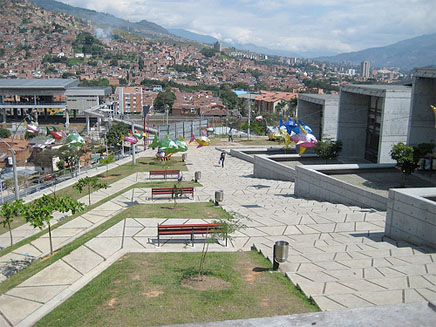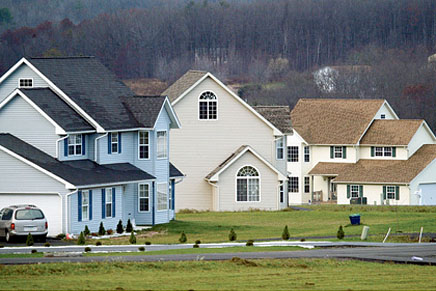

This is not a scientific statement by any means, but I think it’s reasonable to assume that every universe pretty much gets just one big bang.
However, architecture and planning (both professions in which I have some experience) generally are practiced as if the opposite was the case. Not in a literal sense, of course. It isn’t like we walk around our offices worrying about celestial events. Yet we are clearly entranced with the possibility of using our arts to magically sweep aside - all at once - every wrong that we see before us; replacing entire cities and neighborhoods with little mini-novas of creative destruction. The Big Bang model of urban planning – where existing matter is rubbed out, the new stuff is all good, everything is pre-decided, and the outcome inexorable. It’s very mechanistic.
Our history of big ideas is filled with plans for the future that start with dismantling the present, as if the first step towards utopia must begin with resetting everything to zero. It is easy to understand the seduction. The approach requires immense confidence and vision to carry out, and even if it isn’t successful, that whole confidence in working towards a worthy cause thing just feels damn good. Let’s face it, uncertainty is a downer and any theory that points the way towards a happier future is better than muddling along in the status quo. I can understand that. What I don’t get is why we seem to so readily accept that all the good ideas have to be reverse-engineered from the future. Or alternatively, dredged up from the past. Is there really nothing in the here and now we can’t use to stake our futures on?
I think there might be. Unfortunately, most of the examples that make their way to the popular press come from the developing world, in the form of enchanting stories like Slumdog Millionaire, or the energetic research of Koolhaas’ study of Lagos. Messy urban landscapes the world over are being given the nod, finally worthy of study. Which is great, but curiously few of those landscapes are found in the West. But I’ll get to that later.
In the meantime, to get a feel for what this fascination with messiness means, consider the example of an ongoing project in Medellín, Colombia – begun by the city’s former mayor, Sergio Fajardo. Facing urban poverty and crime in the enormous slums around his city, the mayor chose to ignore the possibility of Big Bang renovation. Instead he decided to invest money and energy in the erection of precious cultural infrastructure in the very middle of the poorest parts of his home. Beautiful modern libraries, schools, and cable cars now connect the slums to the rest of Medellín; but what is most interesting is that his additions are not walled off from the existing urban landscape. Medellín's San Javier Library Park by architect Javier Vera Londoño. Photo by Quilian Riano, from his Harvard school blog
Medellín's San Javier Library Park by architect Javier Vera Londoño. Photo by Quilian Riano, from his Harvard school blog
How remarkable is that? It is nothing less than an attempt to improve the most troubling parts of a city by embracing them. Not in a romantic way. No one is pretending poverty is remotely beneficial to anyone. And yet, when it mattered, Mr. Fajardo entertained the possibility that his slums are actually part of a legitimate landscape.
It is too soon to know if the experiment will work in the long run, but it represents a vision of planning that is remarkable because it is not fixated on ensuring any kind of pre-cooked future. There IS a vision, but it is one in which the final form is not yet imagined. It is a kind of planning for the present; contingent, flexible, and open.
That is pretty potent. So why aren’t planners and designers in more developed countries implementing more contingent, flexible, and open models of urbanism? We seem instead to prefer our urbanism neat and clean and easy to digest. If we can make our plans bigger, all the better. Which, come to think of it, is probably why China and The Middle East have garnered so much attention in the architectural press of late. Cities planned from scratch, built in recognizable and ironic shapes if at all possible, self-contained, and ALL according to a single plan. It’s a Big Bang wet dream.
Big Bang urbanism is always the favored option. But how does the Big Bang work in mature cities? Cities where the first consideration is not how to manage growth, but how to maintain quality of existing urban space, or simply to survive with a radically shrinking population. The developed world’s version of ad-hoc urban growth – suburbia! - certainly doesn’t elicit the same marveling response that uncontrolled fringe settlements get from visitors to the developing world.
Past or future? Photo by Suzanne Dichillo, NewYorkTimes/Redux, via The Atlantic
To be fair, in many ways that is the correct reaction. But I wonder, why don’t we look at our own cities with the same open eyes as we look at places like Mumbai or Medellín; searching not for failure and horror, but for potential? Is the unplanned city only valid if it’s dense and dirty? Why don’t we see our cities as legitimate landscapes from which we can build our future?
The closest we seem to get to that possibility is in the form of ideas that might be called Big Bang Lite – where the ideal is reformation rather than complete reconstruction. In the case of suburbia the need for reform is justified by the need for sustainability. Fair enough. Yet the impression is that sustainability is being used as an excuse to invoke the ideals of Big Bang urbanism - the final picture is pre-determined, comprehensive, inflexible. When I see projects of this type, whether they are set out by New Urbanists hoping to bring urban densities to the suburbs, or whether they are offered up by those brave few who concede suburbia may be a creation of people who actually LIKE where they live, I cannot help but feel we are missing two important points.
First of all, that sustainability does not require density. Michael Jenks in his series of books on sustainable urbanism showed that while urban form matters, there is still no evidence that a dispersed plan is inherently any less or more sustainable than a dense one. It seems likely that what is really important is not so much the actual form of our cities as how we live in them. To give you an example of what I mean, ask yourself, if our cars were benign, energy neutral and non-polluting, would we still need to dismantle suburbia? If our homes were self-contained, independent of any kind of infrastructural grid would there still be any need for density? These are important questions that are not ever going to be asked if we continue to approach planning from the future. The Big Bang vision of planning does us the dis-service of assuming such questions are irrelevant.
The second point requires a little populist faith, but starts with the assumption that our cities are reflections of the people who live in them. If we want to plan for a sustainable future we have to admit humanity is perverse, preferring to live in ways we cannot predict in advance. Flexibility is not a luxury it is a necessity, and Big Bang urbanism is not very good at that sort of thing. In fact it tends to insists on being deaf to other ideas. It is a closed system, where progress is allowed to go in only one direction, even if society veers off in another direction entirely. We need room to accommodate unexpected needs when they come up.
Don’t get me wrong. I am not advocating for a get out of jail free card for suburbia or for any modern city. Suburban cities in the North America are as problematic as Mumbai or Medellín – pollution, and social inequality are as damaging in Chicago, Detroit or London, and the current version of suburbia is not helping at all. Something has to give.
But I question our confidence in what shape our future needs to be. The last several hundreds of years of urban planning prove that what we know about cities is never enough, and often barely even correct. While there is certainly a place for big ideas, we need to be ready to accept more than ONE idea at a time. We need to leave dogma behind, admit our cities are part of a legitimate landscape, and think about finding paths to all kinds of good futures from where we are standing today. Some of those futures might look like suburbia. Some might look entirely different, but they can ALL be correct. We need diversity, not the mono-culture of Big Bang ideas.
Creative Commons License
This work is licensed under a Creative Commons License .
/Creative Commons License
I split my days between teaching at Toronto Metropolitan University and running my office frontoffice tokyo. frontoffice is a planning and architecture firm located in the heart of what is (for now) still the largest mega-city in the world, Tokyo. Taking advantage of our location we are ...
10 Comments
Fantastic piece and really thought-provoking, jump. The first sentence is quite a shocker and a great frame for the whole notion of how we tend to think about cities.
Jump this is very well written and I eagerly anticipate a continuation of this argument.
My own interests however have been piqued by your statement about the "curiously few [..] landscapes found in the West" that are studied, validated and ultimately modelled. Especially since the latter is always geared towards the extremely dense megalopolis - it seems as if the model for smaller less concentrated communities/towns/centres always fall short relying on the histrionics of new urbanism or some other sort (Poundbury)
again... brilliant job
I think you're right, most alarm clocks do have snooze buttons now.
Jump, have you ever noticed how at parties people will jam into the kitchen? Why do they do that, there's a whole big house available. Well, the food is there, but also, all sorts of interesting things tend to happen when you're squeezed together that don't happen when groups of two are spread throughout a large house.
"If our homes were self-contained, independent of any kind of infrastructural grid would there still be any need for density?"
Yes, but I suspect you know that.
Really good... As a third year student in architecture, my interest in urban design/planning continues to grow as I go through school and this helped to justify the initial discomfort I feel when looking at pretty renderings of new, mega-cities.
However, to see this argument come to reality, might it seem that architects will have to be willing to sacrifice their egos? We use the "Big Bang" theory to attempt to disprove God; and ironically, architects render Big Bang images to attempt to prove that they are God. I wonder when and how this shift might occur.
i agree emilio. what i question is when people try to make houses where the law says only kitchens are allowed.
We need MORE diversity not less. Like the rain-forest and bio-diversity, our cities need diversity too. Yet we seem to be aiming for reduction. This makes no sense to me. A great deal of research has been done that shows density is good. A great deal has been done that shows density is also not good. Very little research has been done that examines what we get from suburbia, or other kinds of fringe urbanism. Which is odd. 50% of the current economy and population live on the urban fringe, and we are ignoring it as a starting point for design? How short-sighted is that?
Nice piece jump.
I have often wondered why most of the top architecture schools send their students all over the world for studio projects. I remember seeing in the Columbia school blog recently that every single studio was traveling to either South America or Asia. Don't we have enough problems with our own cities? Why aren't we doing studios in American cities? Or in the suburbs?
Architphil,
That is a really good question..
It would seems applying to real world local issues would at least within state school system(s) be key to meeting the land grant college(s) mission....
While it is true that many people are fascinated with the Big Idea, most architects and planners spend their time on very small projects, trying to make some improvement to a small place. So what you are suggesting is really how the world works anyway - each of us trying in our small way to make our little corner of the world a better place. One building at a time, one development proposal at a time, one zoning change at a time, the next community meeting - that is the world most of us live in. We are not focusing on a Big Bang.
the planner in our office says the same thing JoeM. I understand that point, but at the same time I think Big Bang Urbanism is not related to scale. Small stuff, one house, one block, one landscape, can all be Big Bang in essence. The idea to me is one where the designer/architect/planner/whatever decides the city should be X and then treats the small project or large project as chance to make a piece of X. The only reason scale is not big is because of opportunity not attitude. Local constraints that prevent being actually Big do not preclude us in any way from assuming we know what the world should be.
It is an attitude that says, if everyone would just do as I say then the world could be fixed. That is what i see with suburbia today. What I see in the center today too, for that matter. There are so many different directions we could go today and yet i see more a hardening around conventional wisdom than a mood of experimentation. In the real world where planners have to deal with people and institutions I can understand that, but there is no excuse in academia, amongst teachers, researchers, or others.
The reason this bothers me most is because I think that the conventional wisdom is not remotely enough. Density, walkability, New urbanism, whatever, these are all valid and useful ideas but they are not going to make the world all better. So what I would hope for is that while we continue to develop the conventional line we also look real hard into what else is possible. Because that is where the innovation is going to be.
Right now we need a Cambrian explosion, not controlled evolution.
Block this user
Are you sure you want to block this user and hide all related comments throughout the site?
Archinect
This is your first comment on Archinect. Your comment will be visible once approved.